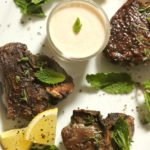Hi, everyone. Today I’m pleased to introduce you to Doug, The Kitchen Professor! He has a unique blog that covers all the practical things you need to know about working efficiently in your kitchen. I am so glad I met Doug because I have to admit, I’m not very practical! I just sort of take things as they come but after reading some of his articles like the benefits of cast iron cooking and essential knife skills, I am so keen to learn more.
Today Doug is going to talk about knives – their usage, maintenance, sharpening and storage. Great info! Grab your favourite beverage, sit back, relax and learn all you need to know about knives.
Here’s Doug:
My wife bought a few really nice knives after reading some reviews on Product Expert and we had no idea how to care for them. Technically, high quality knife set should last a lifetime – if you know how to care for them.
Knives are one of the most important tools you have in the kitchen. Both pro chefs and home cooks agree about the importance of maintaining kitchen knives in excellent condition. Sharp knives are safer and more fun too.
Let’s take a look at three main areas that will keep your knives in great working order.
Daily Usage
- Storage
- Sharpening
Daily Usage and Ongoing Maintenance
Knives come in many popular forms and styles. Adhering to a few simple daily guidelines helps keep knives in great shape so that food preparation occurs faster, more safely and with a minimum of waste. Many experts confirm that well cared for knives are safer and help improve the final texture of dishes.
Whether you prefer to use one of the best Japanese knives, Western or German kitchen knives, you’ll find these tips helpful in protecting your investment in these tools during everyday use:
Use Cutting Boards
I recommend always using cutting boards with a kitchen knife for a simple reason:
A hard surface may damage or even break a knife blade during the chopping or slicing process.
So never cut on granite, glass, or metal because it is terrible for the knife.
Of course, the best contact surface must also offer a secure, immobilized platform.
The best option is the traditional wooden cutting board. Wood furnishes a forgiving surface that will accept cuts from sharp blades if someone presses too hard.
Yet a heavy wooden cutting board won’t slip or slide away during food preparation and cause accidents. I like the end grain wooden cutting boards because they are even gentler on a blade edge.
I also have a couple composite and plastic cutting boards for meat and for using by the grill.
Wash Promptly by Hand
Another important daily guideline involves promptly washing a kitchen knife by hand following every use. Making this practice a habit enables the blade to remain functional and immediately available for re-use. You won’t accidentally contaminate one dish with the ingredients from another.
Avoid Placing Knives in Dishwashers
Although modern appliances offer great convenience sometimes, they also don’t safeguard and protect essential tools sufficiently. Using the dishwasher to repeatedly clean a kitchen knife will eventually degrade the tool and shorten the knife’s functional lifespan.
The problem is the blades will bump into other objects and over time the knife edge will become dull. In addition, some really nice knives may have wooden handles and the heat in the dishwasher will damage the wood.
Use a Honing Steel Frequently
Use a honing steel every time you use your knives. A honing steel will re-align the microscopic knife edge so it will seem sharper.
Although a honing steel will not transform a dull blade into a sharp one, making a practice of using it often helps sharpened blades retain their shape longer. That means you won’t have to sharpen your knives as often.
Storage Options
While some knives display traditional durable steel blades, blades using cladding, titanium and ceramic have also attained widespread popularity. The best storage option for these valuable tools remains largely a matter of personal preference except for one…
Never Store Knives in a Drawer
You should never to store kitchen knives along with other utensils in drawers. Not only can these blades cause nasty accidents if someone unfamiliar with the drawer reaches blindly for items inside and grabs a sharpened blade inadvertently, but the jostling of the blade against other cutlery could potentially damage a sharp cutting edge.
Storing knives in a drawer will make them dull much faster so don’t do it.
Magnetic Strips
This is my favorite way to store knives – magnetic strips. The knives are easily accessible and they can’t bump into each other.
I also like to have the knives on display.
Knife Sleeves
Another popular way to store kitchen knives involves using individual padded knife sleeves. A sleeve bears some resemblance to a scabbard; it protects and safeguards an individual blade from bumps and jostling that might dull or dent the metal.
This covering also prevents someone from accidentally picking up a sharp knife by the blade while hunting for kitchen utensils if you have to keep knives in drawers.
I use knife sleeves when I travel so I can bring a couple knives from home.
Knife Blocks
One traditional storage option which still enjoys popularity involves the use of a knife block. Essentially, this item consists of a block of wood with slots designed to securely hold knives of specific lengths.
Often a manufacturer will supply customers with a block capable of holding a series of different blades. This form of storage offers great convenience by keeping the knives readily available for use.
Depending on their design, knife blocks may rest atop counters or even sit within individual kitchen cabinets.
My main gripe with storage blocks is that you can’t really clean inside the blade slots. If you know of a way to clean them, let me know!
Knife Sharpening
Yet a third critical area of kitchen knife maintenance involves keeping knives sharp and ready to perform. Razor-sharp blades enable a kitchen knife to cut, slice, chop, and dice food easily.
Dull blades by contrast sometimes cause multiple problems. They may create accidents during food preparation – if the blade cannot immediately penetrate an item and a frustrated handler applies too much pressure. Additionally, dull knives slow down the cooking process considerably. Many chefs maintain they damage the texture of some dishes.
Sharpen All Knives
All knives at some point will require sharpening. While ceramic and titanium blades grow dull infrequently due to the hardness of the cutting material, they also eventually lose their edge after extensive use on certain items. Professionals with expensive diamond grinding equipment can sharpen these types of specialized blades.
For stainless steel blades, consider using either an electric sharpener or a manual sharpening system. You’ll know a kitchen knife requires sharpening if small burrs develop along the precision thin cutting edge. Generally, I like to sharpen my knives about once a quarter, and I use mine a lot.
Electric Knife Sharpeners
Today a wide array of electric knife sharpeners provide a rapid way to restore the razor-sharp cutting edge of a kitchen knife. The main advantage to electric sharpeners is that they are fast and convenient.
You can sharpen a dull blade in about 90 seconds with an electric sharpener. If the knife just needs a touch up, then it may only take 15 seconds. I recommend an electric sharpener for most people due to the speed.
Manual Sharpening Systems
For centuries, knife owners around the world used manual sharpening systems involving hard rocks to create precision-thin blade edges. Consumers today will find many different models and shapes of sharpening stones available. These products occur in different grades of hardness and in many different sizes.
Typically, a sharpening stone consists of a flat, well-polished rock surface or surfaces. Follow the product directions to achieve a very finely honed edge on a blade which has become dull by dragging it over the surface away from you at a 22 degree angle. Afterwards, use a damp cloth to carefully clean away any debris on the knife blade. If you are in need of a manual knife sharpener then check out this review of the Bavarian Edge knife sharpener.
The main issue is that it takes a while to sharpen each knife – it may take 10 to 20 minutes for each knife. So, think about the time that you want to invest in knife maintenance.
Conclusion
A quality set of knives can last a lifetime if you take the time to maintain them. It is worth the effort and most of that effort is about adopting a few habits that keep the knives safe.
Remember:
- Use a cutting board.
- Wash and dry your knives by hand.
- Use a honing steel.
- Store your knives on a magnetic strip, in sleeves, or in a knife block.
- Don’t store knives in a drawer – it is dangerous.
- Sharpen your knives once a quarter or whenever they need it.
Helpful links
- 10 Tips for Knife Buying by Alton Brown of Good Eats
- How To Select a Kitchen Knife Sharpener – A Guide
- How To Care For Kitchen Knives by the Huffington Post
Doug blogs at The Kitchen Professor, and while his degree is honorary (bestowed upon him by his wife), he has enjoyed cooking his whole life. He loves using old cast iron, BBQ,and loves adding the small, special touch to a recipe that takes it from just “okay” to “wow.”









18 Comments
Anita Rivera
September 17, 2015 at 4:55 amGood morning dear friend! Now this is a post I need to STUDY. I have to admit that my knife maintenance is not very good or regular! And I really do need to get a chopping board. I use a PLATE! Shhhhhh…….that is what a hurried life and neglect of true culinary art has produced in me. There was a time I was great in the kitchen. Not now!
So then on that note, here I rush off to work. Much love. Anita
Doug (the kitchen professor)
September 17, 2015 at 12:29 pmHey Anita, Thanks for checking out the post!
Knowing is half the battle and you can probably get chopping block before the holiday cooking season arrives.
Doug (the kitchen professor) recently posted…All About Cutting Boards – Search for the best
Marie
September 17, 2015 at 7:50 amThere are so many great reminders in this post. I’d love to store my knives on a magnetic strip but I have no good space on any of my kitchen walls to do that, so they are relegated to a drawer – but at least it’s a dedicated drawer for knives. And I use sleeves whenever I have them. I also need to sharpen them more often. We typically get some of them sharpened each year at the farmer’s market, but I don’t always think to do it at home too. Too much of a hurry I guess. Like I said, good reminders!
Doug (the kitchen professor)
September 17, 2015 at 12:31 pmHey Marie,
Thanks for reading the post. We just moved to a new place and I am not sure where the magnetic strip should go. I can relate — We do have more counter space now so the knives are on the counter in sleeves. 🙂 Shhh…don’t tell anyone.
Doug (the kitchen professor) recently posted…All About Cutting Boards – Search for the best
Kathryn Grace
September 17, 2015 at 2:13 pmThank you for this. I’m on my second set of knives, the first having been ruined by a professional knife sharpener, or so he calls himself. I’ve often wished I had my dad’s whet stone. He used to sharpen my mom’s knives for her, and I’ve never seen one for sale.
Shared on Facebook and pinning so I can find it again. Thank you!
Kathryn Grace recently posted…Touring Eatwell Farm–Food for the body and soul
Doug (the kitchen professor)
September 21, 2015 at 9:31 amHi Kathryn, Sorry to hear about your knives that were ruined! That’s terrible, especially when you think you are doing a good thing by going to a pro.
Good luck on the next set..I guess you will have to take the sharpener role to keep them in good shape.
Doug (the kitchen professor) recently posted…All About Cutting Boards – Search for the best
cheri
September 17, 2015 at 9:35 pmHi Robyn, our knife maintenance is like our cutting board maintenance, horrible!!! great post!
cheri recently posted…Sunflower Sesame Seed Brittle Chew and a Food Truck
Doug (the kitchen professor)
September 21, 2015 at 9:28 amHey Cheri, Thanks for checking out the post. That reminds me – I need to oil my cutting board!
Doug (the kitchen professor) recently posted…All About Cutting Boards – Search for the best
Bam's Kitchen
September 17, 2015 at 10:34 pmThank you Doug and Robyn for this great post! I have many Japanese knives and yes they are amazing but they need lots of maintenance. I am long over due to visit Chan Chi Lee Cutlery Co. here in Hong Kong as they do a great job sharpening knives and I adore my Chinese clever that I purchased there as well. I am sharing this post everywhere!!!
Bam’s Kitchen recently posted…Negima Yakitori with Grilled Portobella & Giveaway
Doug (the kitchen professor)
September 21, 2015 at 9:33 amHey Bam, thanks for reading the post and shares!
I love Japanese knives for most things, and I agree about the extra maintenance. It is worth it though!
Doug (the kitchen professor) recently posted…All About Cutting Boards – Search for the best
Gourmet Getaways
September 17, 2015 at 10:40 pmWhat a great story, I love getting out and about.
Thanks for sharing
Julie
Gourmet Getaways
Gourmet Getaways recently posted…Where To Visit In Turkey
Doug (the kitchen professor)
September 21, 2015 at 9:34 amThanks for reading the post!
Doug (the kitchen professor) recently posted…All About Cutting Boards – Search for the best
Linda
September 19, 2015 at 1:06 pmGood to know. I am sure I am failing on a lot of these topics…I also need to buy a really good knife.
I have my knives in a block on the counter. Thanks for the tips Robyn. It was great chatting with.
Have a lovely weekend. Lots of love from W.W. xo
Linda recently posted…Tragic Fire in Lake County
Doug (the kitchen professor)
September 21, 2015 at 9:37 amHi Linda, It is tough to keep up on everything for knife maintenance. If you can just keep up 1-2 habits it will go a long way. And, the knife block is a fine way to store knives. 🙂
Doug (the kitchen professor) recently posted…All About Cutting Boards – Search for the best
Martin Porter
March 28, 2016 at 2:06 amGreat suggestions. I am planning to get a magnetic strip for my knife. I liked the idea of displaying my knife set in the kitchen.
Andrew Flintoff
June 9, 2017 at 5:29 amWow mind blowing article on knife, I really appreciate it. Can you please also let me know where I can get Army Knife from ? I am thinking of buying it as it really looks cool, do tell me. Thanks 🙂
Eve
June 12, 2017 at 10:43 pmCool post Doug. I’ve always hated the marble/ceramic cutting boards and can never understand why people would buy them. What kind of sharpener do you use these days? Stone, electric, or pull through?
Eve recently posted…3 Solid Reasons To Start Oiling Your Knives
EL Mehdi
August 31, 2018 at 11:36 amis Electric sharpener better than manual one?